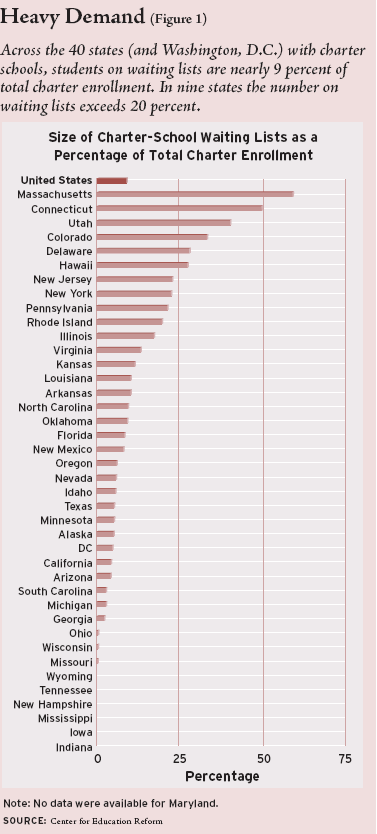 The charter school movement turns 14 this year, and its behavior, some might say, is “developmentally appropriate.” Unruly and temperamental, impassioned and energetic, growing in fits and starts and fiercely independent, even friends and supporters aren’t quite sure what to do with it. And now comes the apex of adolescence: the identity crisis.
The charter school movement turns 14 this year, and its behavior, some might say, is “developmentally appropriate.” Unruly and temperamental, impassioned and energetic, growing in fits and starts and fiercely independent, even friends and supporters aren’t quite sure what to do with it. And now comes the apex of adolescence: the identity crisis.
Like most Americans who have ancestors from multiple countries or even continents, charters were born of disparate theories, education initiatives, and social philosophies. That diversity has been one of the greatest strengths of the big family that is the charter movement. But now public policies–certainly No Child Left Behind (NCLB), but also the state standards movement that preceded it–are forcing conversations long delayed. The most fundamental question is, What’s the point of charter schools anyway?
In the early 1990s, at the inception of charters, the bargain was set. These schools would be given greater autonomy and flexibility than traditional public schools, and in return they would be held accountable for getting better results in student learning. And, just as critically, they would be schools of choice for everyone involved–students, parents, and teachers. Two sides of the charter triangle–autonomy and choice–have remained quite clear and without controversy, at least within the charter movement itself. Parents should have plenty of choices; and the more autonomy and flexibility, the better. And it is clear that the charter model has succeeded in attracting applicants (see Figure 1).
But regarding the third side–accountability for results–the conversation was purposefully ambiguous. What results? Measured how? Compared with what? Rather than forcing a standard answer to these questions, policymakers and charter sponsors allowed schools to develop contracts that were customized to their specific contours.
 Schools had the freedom to make the case to their state or local overseers for their contracts and accountability plans to reflect their unique pedagogical approaches. If the school was of the progressive stripe, for example, attracting parents and teachers who abhorred standardized testing, then portfolios of student work might serve as the indicator of success. If the school served an at-risk population, such as high-school dropouts, expectations might be adjusted accordingly. In effect, it was accountability sans standards.
Schools had the freedom to make the case to their state or local overseers for their contracts and accountability plans to reflect their unique pedagogical approaches. If the school was of the progressive stripe, for example, attracting parents and teachers who abhorred standardized testing, then portfolios of student work might serve as the indicator of success. If the school served an at-risk population, such as high-school dropouts, expectations might be adjusted accordingly. In effect, it was accountability sans standards.
As the 1990s progressed, however, and the state standards movement gained strength, the ambiguity around accountability–for charters but also for other public schools–started to recede. Elected representatives decided that it was appropriate to expect all public school students to know and be able to do certain things. Furthermore, they determined that statewide assessments were reasonable tools to measure whether this learning had in fact happened. And, by the end of the decade, some states were ready to hold schools to account for education success or failure.
Finally, by 2002, through the No Child Left Behind act, the public’s elected representatives took decisive action to close the achievement gaps plaguing our nation–and to hold all public schools, including charter schools, accountable for making progress toward that end. Some simple but powerful principles were codified in the law: every child can learn–and to expect anything less is a form of bigotry, which should stop.
Autonomy versus Accountability
So here we are, 14 years after the birth of charters, looking into the mirror at an identity crisis. Some in the charter school movement, viewing autonomy as its most important animating principle, responsible for so much of the innovation and energy in the 3,300 charter schools across the country, argue that the testing regimen at the heart of the standards movement and NCLB will leave charters hidebound, soulless, bureaucratized.
Is that a reasonable concern? Let’s return to the fundamental question: What’s the point of charter schools anyway?
If the only point is for schools to be innovative, experimental, and risk-taking, like the alternative schools of the 1960s, then exemption from statewide testing and accountability systems, and adoption of unique goals and objectives for each school, might make sense. But what if the point of charter schools is to dramatically raise student achievement and close the achievement gaps so that all young people have a chance to participate in our democracy and economy? What if the point is to innovate, experiment, take risks, and bring in new energy and ideas in order to perform at levels higher than otherwise possible?
In practice, this debate over the point of charter schools has itself reached a critical juncture. NCLB, supported by an overwhelming bipartisan majority in both houses of Congress, makes it clear that all public schools–including charter schools–must be held accountable for raising student achievement and closing achievement gaps. In particular, schools are expected to make their state-set achievement goals (“Adequate Yearly Progress” under the law) to ensure that all children learn to read and do math.
At What Cost Proficiency?
How much of a threat to charter autonomy are this law and the related state accountability systems? Is proficiency in math and reading too heavy a burden to carry? I would argue that excellent charter schools, no matter how traditional or progressive, can handily meet the achievement expectations of state accountability systems while maintaining their distinct character. The requirements of NCLB are merely a starting point. Schools can build on statewide testing with their own “authentic” assessments of student learning, such as portfolios or demonstrations. And while ensuring that their students are literate and numerate, they can go on to provide a full, well-rounded education, defined as they see fit.
Schools of all kinds of educational persuasions can meet and are meeting the standards demanded by states and NCLB. The Office of Innovation and Improvement in the U.S. Department of Education went looking for examples of some of the best charter schools in the nation, as measured by state assessments, and found a wide variety of institutions getting the job done. The resulting booklet, Innovations in Education: Successful Charter Schools, highlights some by-the-book miracle workers like KIPP Houston and Boston’s Roxbury Prep. But it also includes entries like the School of Arts and Sciences in Tallahassee, Florida, which features interdisciplinary learning, portfolios, and multi-age classrooms, and does without grades, report cards, or kids sitting in rows. What the schools all have in common is that they made adequate yearly progress under NCLB and otherwise demonstrated impressive student-achievement gains.
Granted, the achievement-level design of the NCLB accountability system creates some challenges for new schools like charters. Many charter schools purposefully recruit students who historically have been left behind by the traditional public schools; many of them are at-risk students. Especially for charter high schools, with students entering three, four, or five years behind, this presents a unique challenge. Some in the charter movement might prefer a value-added approach to accountability, one that looks at the gains made in student learning each year. In fact, there is a version of this system built into NCLB’s so-called safe harbor provision, which finds a school’s progress adequate if it increases by at least 10 percent, the number of students who are proficient, even if the school does not meet its achievement target. Whatever the system, though, it is important that we expect all students to achieve proficiency. Can educators–in charters and in other types of schools–say that their students are well prepared for life and further learning if they can’t read or do math at grade level?
While the accountability demands of NCLB could lead some charters–those exploring the furthest frontiers of education practice–to modify their programs, a much greater impact will be felt by charters that are low performing by any measure. And this may be the law’s greatest gift to the charter movement. It is already clear that many charter schools will be labeled “in need of improvement” under state accountability systems and NCLB. (According to the Government Accountability Office, as early as 2002-03, 25 charters in California, 28 in Michigan, and 38 in Pennsylvania needed improvement because they did not have enough students in certain subgroups reaching proficiency in reading or math.) While some of these schools are likely making great progress with students who started out far behind, others are unquestionably underperforming. As they face the steadily increasing improvement measures triggered by NCLB, many charters will surely be closed by their authorizers. And that will be a victory for the charter movement in the long run.
Why a victory? Because without the pressure of state accountability and NCLB, precious few authorizers have been willing to pull the trigger on underperforming charters. In a culture that can’t get enough of Donald Trump and his “Apprentice,” we have been terribly gun-shy about telling charters those two important words: “You’re fired!”
This lack of political courage has consequences–not only for the kids in the failing schools, but also for the charter movement itself. The year 2004 was difficult for charters, with the well-placed, well-spun American Federation of Teachers “study” taking center stage in a bruising battle between charter critics and supporters. The report–and the New York Times, which “broke” the story on its front page last August–was roundly criticized by researchers for its inadequate methods. (See “Gray Lady Wheezing,” Education Next, Winter 2005.) While the official release of the National Assessment of Educational Progress (NAEP) data demonstrated that the sky had not fallen–after controlling for race, as many had pointed out, any differences between charters and traditional public schools washed out–the news was no reason to celebrate either. Again, if the point of charter schools is to raise achievement and close achievement gaps, there’s plenty of evidence that some charters are not pulling their weight. These are the schools most likely to face the ultimate consequence of closure under NCLB. That will make the whole charter movement stronger.
So in which direction is our 14-year-old heading? Which identity will it assume? It can throw tantrums, declare its disgust with the “system” that is NCLB-style accountability, and become a teen rebel. Or it can work through its growing pains, coming to grips with the responsibilities of a mature education movement while also maintaining and celebrating its uniqueness and independence. I am hopeful that the charter movement will find its way, never giving up the innovation and energy that make it special, but also shouldering the load of helping to close the nation’s achievement gaps. And when it does so, it will be declared not only a success in its own right, but a role model for the entire public education system.
Michael J. Petrilli is associate assistant deputy secretary in the U.S. Department of Education’s Office of Innovation and Improvement, which houses the federal charter-school grant programs.


